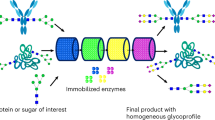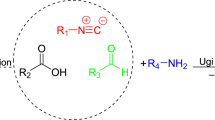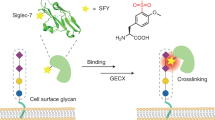Abstract
We have constructed a fusion protein between the staphylococcal A protein and the cellulose binding domain of an exoglucanase (Cex) from Cellulomonas fimi that can be directly immobilized on cellulose while retaining its capacity to bind immunoglobulin G molecules. The cellulose domain provides binding that does not interfere with the biological activity of the fusion partner, does not involve hazardous chemicals and the matrix does not need to be chemically activated which reduces its cost. We have tested some of the possible applications of the fusion protein and show that it can be used in immunoassays, affinity chromatography and immunoprecipitations.
This is a preview of subscription content, access via your institution
Access options
Subscribe to this journal
Receive 12 print issues and online access
$209.00 per year
only $17.42 per issue
Buy this article
- Purchase on Springer Link
- Instant access to full article PDF
Prices may be subject to local taxes which are calculated during checkout
Similar content being viewed by others
References
Langone, J.J. 1982. Applications of immobilized protein A in immunochemical techniques. J. Immunol. Methods 55: 277–296.
Langone, J.J. 1988. Protein A of Staphylococcus aureus and related immunoglobulin receptors produced by Streptococci and Pneumonococci. Adv. Immunol. 32: 157–252.
Harlow, E. and Lane, D. 1988. Antibodies: A Laboratory Manual. Cold Spring Harbor Laboratory Press, Cold Spring Harbor, NY.
Uhlén, M., Guss, B., Nilsson, B., Gatenbeck, S., Philipson, L. and Lindberg, M. 1984. Complete sequence of the Staphylococcal gene encoding Protein A. J. Biol. Chem. 259: 1695–1702.
Moks, T., Abrahmsen, L., Nilsson, B., Hellman, U., Sjöquist, J. and Uhlén, M. 1986. Staphylococcal Protein A consists of five IgG-binding domains. Eur. J. Biochem. 156: 637–643.
Langone, J.J. 1982. Use of labeled Protein A in quantitative immunochemical analysis of antigens and antibodies. J. Immunol. Methods 51: 3–22.
Pakmer, A., Welsh, K., Gjornstrup, P., Taube, D., Bewick, M. and Thick, M. 1989. Removal of anti-HLA antibodies by extracorporeal immunoadsorption to enable renal transplantation. Lancet 8628: 10–12.
Solomon, B., Raviv, O., Leibman, E. and Fleminger, G. 1992. Affinity purification of antibodies using immobilized FB domain of protein A. J. Chromatogr. 597: 257–262.
Ljungquist, C., Jansson, B., Moks, T. and Uhlén, M. 1989. Thiol-directed immobilization of recombinant IgG-binding receptors. Eur. J. Biochem. 186: 557–561.
Tomme, P., Van Tilbeurgh, H., Pettersson, G., Van Damme, J., Vandekerckhove, J., Knowles, J., Teeri, T. and Claeyssens, M. 1988. Studies of the cellulolytic system of Trichoderma reseei QM9414. Analysis of domain function in two cellobiohydrolases by limited proteolysis. Eur. J. Biochem. 170: 575–581.
Ghangas, G.S. and Wilson, D.B. 1988. Cloning of the Thermomonospora fusca endoglucanase E2 gene in Streptomyces lividans: affinity purification and functional domains of the cloned gene product. Appl. Environ. Microbiol. 54: 2521–2526.
Gilkes, N.R., Warren, R.A.J., Miller, R.C. Jr. and Kilburn, D.G. 1988. Precise excision of the cellulose binding domains from two Cellulomonas fimi cellulases by a homologous protease and the effect on catalysis. J. Biol. Chem. 263: 10401–10407.
Coutinho, J.B., Gilkes, N.R., Warren, R.A.J., Kilburn, D.G. and Miller, R.C. Jr. 1992. The binding of Cellulomonas fimi endoglucanase C (CenC) to cellulose and Sephadex is mediated by the N-terminal repeats. Mol. Microbiol. 6: 1243–1252.
Ong, E., Gilkes, N.R., Warren, R.A.J., Miller, R.C. Jr., and Kilburn, D.G. 1989. Enzyme immobilization using the cellulose-binding domain of a Cellulomonas fimi exoglucanase. Bio/Technology 7: 604–607.
Ong, E., Gilkes, N.R., Miller, R.C. Jr., Warren, R.A.J. and Kilburn, D.G. 1991. Enzyme immobilization using a cellulose binding domain: properties of a β-glucosidase fusion protein. Enzyme Microb. Technol. 13: 59–65.
Ong, E., Greenwood, J.M., Gilkes, N.R., Kilburn, D.G., Miller, R.C. Jr. and Warren, R.A.J. 1989. The cellulose-binding domains of cellulases: tools for biotechnology. Trends Biotechnol. 7: 239–243.
Greenwood, J. M., Gilkes, N.R., Kilburn, D.G., Miller, R.C. Jr. and Warren, R.A.J. 1989. Fusion to an endoglucanase allows alkaline phosphatase to bind to cellulose. FEES Lett. 244: 127–131.
Nilsson, B., Abrahmsén, L. and Uhlén, M. 1985. Immobilization and purification of enzymes with Staphylococcal protein A gene fusion vectors. EMBO J. 4: 1075–1080.
O'Neill, G.P., Goh, S.H., Warren, R.A.J., Kilburn, D.G. and Miller, R.C. Jr. 1986. Structure of the gene encoding the exoglucanase of Cellulomonas fimi. Gene 44: 325–330.
Langone, J.J., Boyle, M.D.P. and Borsos, T. 1978. Studies on the interaction between Protein A and Immunoglobulin G. II. Composition and activity of complexes formed between Protein A and IgG. J. Immunol. 121: 333–338.
Ngai, P.K.M., Ackermann, F., Wendt, H., Savoca, R. and Bosshard, R. 1993. Protein A antibody-capture ELISA (PACE): an ELISA format to avoid denaturation of surface-adsorbed antigens. J. Immunol. Methods 158: 267–276.
Yanisch-Perron, C., Vieira, C. and Messing, J. 1985. Improved M13 phage cloning vectors and host strains: nucleotide sequences of the M13mp18 and pUC19 vectors. Gene 33: 103–119.
Sambrook, J., Fritsch, E.F. and Maniatis, T. 1989. Molecular Cloning: A Laboratory Manual, 2nd. ed. Cold Spring Harbor Laboratory Press, Cold Spring Harbor, NY.
Sanger, F., Nicklen, S. and Coulson, A.R. 1977. DNA sequencing with chain-terminating inhibitors. Proc. Natl. Acad. Sci. USA 74: 5463–5467.
Tabor, S. and Richardson, C.C. 1987. DNA sequence analysis with a modified bacteriophage T7 DNA polymerase. Proc. Natl. Acad. Sci. USA 84: 4767–4771.
Laemmli, U.K. 1970. Cleavage of structural proteins during the assembly of the head of bacteriophage T4. Nature 227: 680–685.
Pluskal, M.G., Przekop, M.B., Kavonian, M.R., Vecoli, C. and Hicks, D.A. 1986. Immobilon™ PVDF transfer membrane: A new membrane substrate for Western blotting of proteins. Bio Techniques 4: 272–283.
Lacks, A.S., and Springhorn, S.S. 1980. Renaturation of enzymes after polyacrylamide gel electrophoresis in the presence of sodium dodecyl sulfate. J. Biol. Chem. 255: 7467–7473.
Birk, H.W. and Koepsell, H. 1987. Reaction of monoclonal antibodies with plasma membrane proteins after binding on nitrocellulose: Renaturation of antigenic sites and reduction of nonspecific antibody binding. Anal. Biochem. 164: 12–22.
Author information
Authors and Affiliations
Rights and permissions
About this article
Cite this article
Ramírez, C., Fung, J., Miller, R. et al. A Bifunctional Affinity Linker to Couple Antibodies to Cellulose. Nat Biotechnol 11, 1570–1573 (1993). https://doi.org/10.1038/nbt1293-1570
Issue Date:
DOI: https://doi.org/10.1038/nbt1293-1570
This article is cited by
-
Expression of family 3 cellulose-binding module (CBM3) as an affinity tag for recombinant proteins in yeast
Applied Microbiology and Biotechnology (2011)



